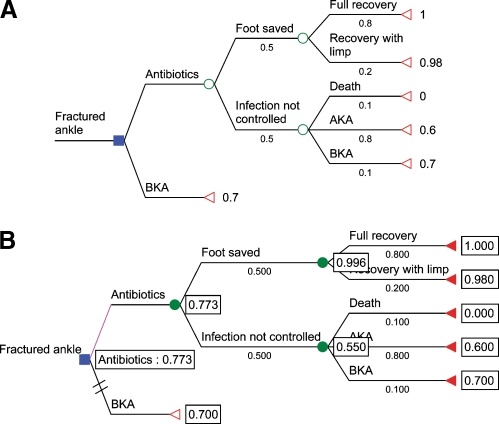Figure 2.
A. The completed decision tree showing the treatment choices and the possible outcomes related to the fractured ankle management problem. BKA=below knee amputation. AKA=above knee amputation. Notice that the probabilities assigned to the possible outcomes at every stage of the process must add to 1.0. Hence 0.5 (“foot saved”)+0.5 (“infection not controlled”)=1.0. B. The utility of each outcome on the right-hand side of the figure is multiplied by the probability of that outcome. The results of these calculations are added together for each chance node to yield the partial utility at that point. For example, at the top right of the tree, the utility value for “full recovery, 1.0, is multiplied by the probability of that outcome, 0.8 to yield 0.8 for that outcome within that chance node. The utility value for the alternative outcome, “recovery with limp”, of 0.98 is multiplied by the probability of that outcome, 0.2, to yield 0.196. The results of these two calculations, 0.196 and 0.8, are added together to yield the partial utility, or “expected value” for that chance node, i.e. 0.996. Likewise, the expected value for “Infection not controlled” is (0 × 0.10) + (0.60 × 0.80)+ (0.70 × 0.10)= 0.55. The overall expected value for “Antibiotics” is (0.996 × 0.50) + (0.55 × 0.50)= 0.773. The expected value of the alternative therapeutic choice, immediate partial amputation, is simply the utility assigned to it by the patient, or 0.7. Hence the value of debridement, fixation, plus antibiotics therapy has a higher expected value in this analysis.

